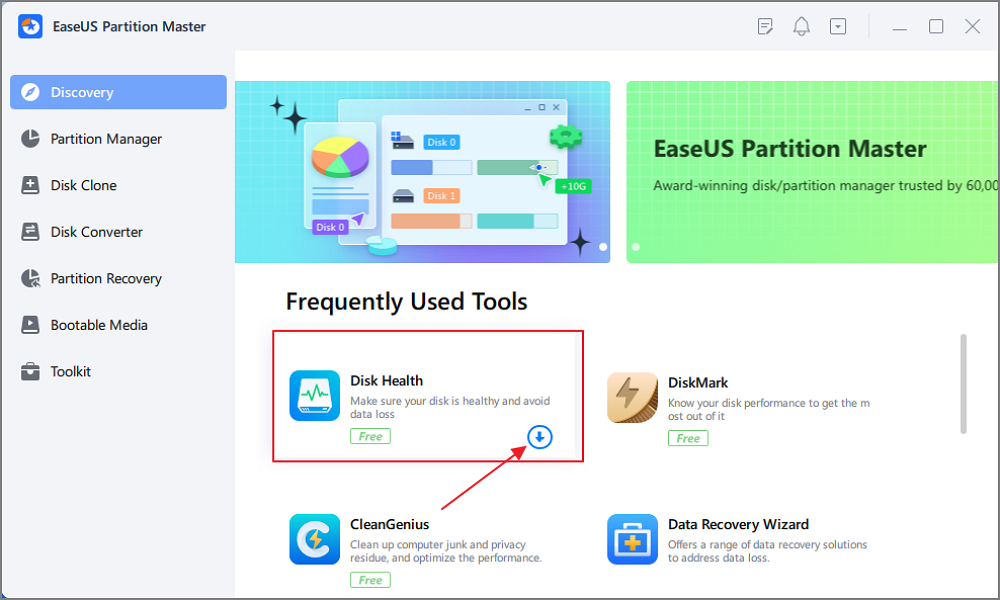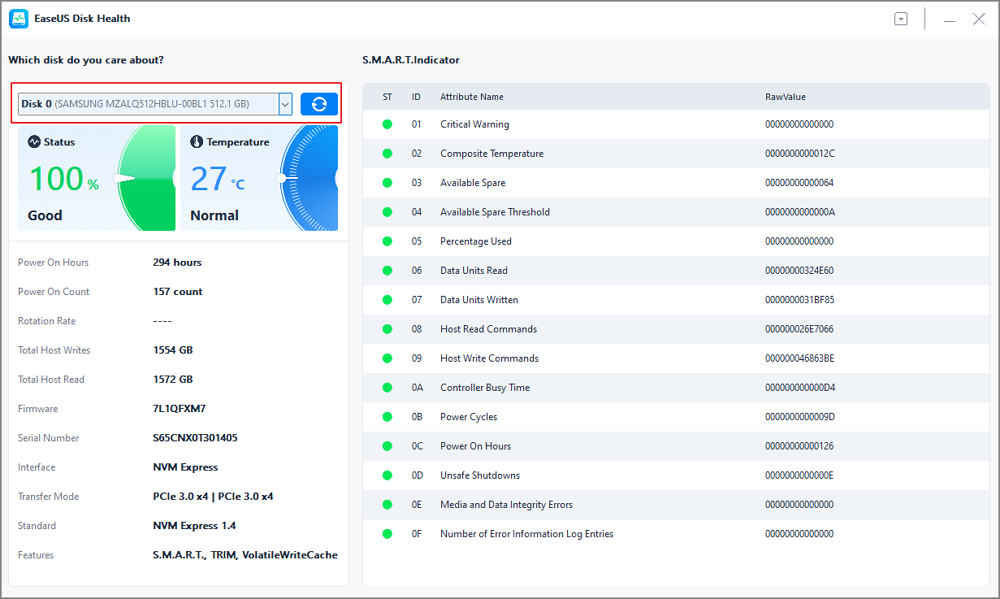Page Table of Contents
About the Author
Hot Topics
Updated on Oct 25, 2024
Are you looking for a way to test your PS5 SSD temperature? Nowadays, PS5 has a large game size, so users can choose a built-in SSD to expand their storage space. When you are playing games consistently, your SSD may get very hot. You may want to know the temperature of your PS5 SSD and decide if you need a PS5 heatsink.
Don't worry. EaseUS will help you understand and check the PS5 SSD temperature before analyzing whether you need a PS5 heatsink.
What Is the PS5 SSD Temperature
Knowing the PS5 SSD temperature range will help us to keep track of the SSD health :
- The normal SSD temperature range should be between 86°F to 149°F or 30°C to 65°C.
- However, when running games, SSD runs fast. Many gaming SSD is designed with this in mind and can often withstand higher temperatures: some SSD is rated to operate at temperatures up to 70°C (158°F).
- Some PS5 SSDs can reach over 71°C without a heatsink and with a cover on. But in the long run, such high temperatures can damage SSD.
- If the PS5 SSD is not in use, its normal temperature should not exceed 40-50 degrees Celsius.
The temperature range of SSD is probably the same whether in PS5 or PC. They will only have some minor differences. Next, we will test the PS5 SSD temperature on a PC and analyze if you need a PS5 cooler.
How to Run PS5 SSD Temperature Test
We already know the normal PS5 SSD temperature range. The next step is to understand how to test the PS5 SSD temperature. To more accurately test the temperature of the SSD with and without operation, we will demonstrate how to test the PS5 SSD temperature on the computer side.
EaseUS Partition Master Free provides the most comprehensive SSD temperature testing tool. It provides Disk Health features to help you check the health, temperature, performance, lifetime, and many other SMART statuses of your SSD. It also helps to prevent SSD failure in advance by alerting you when the SSD temperature is out of normal range.
Download this tool and follow these steps to check the temperature of your PS5 SSD:
Step 1. Launch EaseUS Partition Master and click the blue arrow to activate the "Disk Health" feature under the "Discovery" section.

Step 2. Select the target disk and click the "Refresh" button. Then, you can see the health condition of your disk.

Moreover, this powerful tool is one of the best tools to run SSD performance tests. You can click the following link for more information if you need your PS console.
After testing the temperature of the PS SSD, we can check if its operating and non-operating temperatures are in a normal range against the temperature list. Next, we will analyze if you need a PS5 SSD temperature heatsink. Read on to learn more.
Bonus Tip: Does PS5 SSD Need Heatsink
The quick answer is: Yes, PS5 SSD need a heatsink.
Whether the PS5 SSD needs a heatsink depends on whether its temperature changes with or without a cooler.
TweakTown tested fast travel and saved loading sequences for 10 specific PS games and temperatures with and without an installed heatsink. It took thermometer readings from a K-type thermocouple and a FLIR thermal image of the back end of a PS5 and recorded temperatures at various times. The following approximate data scenarios were derived:
Heatsink Installed:
| Game | 15 minutes | 30 minutes | 45 minutes |
| Far Cry 6 | 38.1°C | 40.5°C | 38.7°C |
| Miles Morales | 30.3°C | 32.7°C | 33.9°C |
| Control | 30.3°C | 31.4°C | 32.2°C |
Without a Heatsink Installed:
| Game | 15 minutes | 30 minutes | 45 minutes |
| Far Cry 6 | 47.4°C | 51.8°C | 54.6°C |
| Miles Morales | 48.6°C | 48.1°C | 52.2°C |
| Control | 43.5°C | 48.7°C | 49.3°C |
From this, you can conclude that your PS5 needs a heatsink. The PS5 heatsink can reduce the SSD temperature by about 10-15 degrees Celsius under the same conditions. A heat sink can transfer the heat generated by electronic or mechanical devices to a fluid medium, which is then emitted from the device.
You will also need to close the expansion bracket shroud if you don't have a heat sink. While the PS5 will not dissipate its heat through the screwed-in shroud, it does trap the heat as it enters.
For more information about Heatsink: Do I Need A Heatsink For My M.2 SSD
Conclusion
This article discusses the PS5 SSD temperature. We need to understand that the temperature range of PS5 is also between 30°C to 65°C. We need to take precautions for SSDs greater than 70°C. Although the PS5 is designed with a good cooling strategy for the whole machine, it will still need a heatsink to make it work. You can either buy an SSD with a heatsink or a separate one and stick it on yourself.
In addition, we need to monitor the temperature and health of the PS5 SSD at all times, and the effect of the SSD on the PC and PS side is roughly the same. To get a more accurate picture of the PS5 SSD, we recommend using EaseUS Partition Master to perform a PS5 SSD temperature test on the PC.
You May Also Like:
FAQs About PS5 SSD Temperature
There are some other topics related to PS5 SSD temperature in this section. If you are interested, read on.
1. How to fix PS5 SSD overheating?
If the PS5 SSD is overheating, you may receive a temperature alert. Please follow the methods to fix the SSD overheating problem:
- Clean up the console.
- Close the game and PS5, uninstall the metal cover of the docking station, and wait for the temperature to drop.
- Install a PS5-friendly cooler, such as a Sabrent M.2 NVMe cooler.
- Provide ample open space for the PS5 console to help dissipate heat.
2. How hot is too hot for PS5 SSD?
The normal temperature for SSDs should be between 30-65 degrees Celsius. In the worst-case scenario, when the PS5 SSD has no heat sink and is covered, the PS5 SSD can reach temperatures of up to 71 degrees Celsius. Excessive temperatures may affect the life of the SSD, so it is best to have a heat sink on hand.
3. Should the SSD be cooled?
Of course, SSDs need to be cooled in the event of overheating. Excessive temperatures can affect the performance and durability of the SSD. So you need to keep the SSD in the normal temperature range to preserve its data and integrity.
How Can We Help You
About the Author
Oliver is an EaseUS professional writer who dares explore new areas. With a passion for solving tech issues with straightforward guides for common users, Oliver keeps honing his writing craft by developing in-depth solutions for disk and partition management, computer boot-up issues, file transfer, etc.
Cici is the junior editor of the writing team of EaseUS. She accepted the systematic training on computers at EaseUS for over one year. Now, she wrote a lot of professional articles to help people resolve the issues of hard drive corruption, computer boot errors, and disk partition problems.
Product Reviews
-
I love that the changes you make with EaseUS Partition Master Free aren't immediately applied to the disks. It makes it way easier to play out what will happen after you've made all the changes. I also think the overall look and feel of EaseUS Partition Master Free makes whatever you're doing with your computer's partitions easy.
Read More -
Partition Master Free can Resize, Move, Merge, Migrate, and Copy disks or partitions; convert to local, change label, defragment, check and explore partition; and much more. A premium upgrade adds free tech support and the ability to resize dynamic volumes.
Read More -
It won't hot image your drives or align them, but since it's coupled with a partition manager, it allows you do perform many tasks at once, instead of just cloning drives. You can move partitions around, resize them, defragment, and more, along with the other tools you'd expect from a cloning tool.
Read More
Related Articles
-
How Do I Run External SSD Speed Test on My Own? Your Guide Is Here
![author icon]() Tracy King/2024/11/27
Tracy King/2024/11/27 -
Fix 'Not Enough Space on the Disk to Complete This Operation'
![author icon]() Brithny/2024/09/19
Brithny/2024/09/19 -
How to Check Samsung SSD Health on Windows [100% Working Solutions]
![author icon]() Cici/2024/11/27
Cici/2024/11/27 -
How to Create Partition from Unallocated Space in Windows 10
![author icon]() Cici/2024/11/27
Cici/2024/11/27
Hot Topics in 2024
EaseUS Partition Master

Manage partitions and optimize disks efficiently








